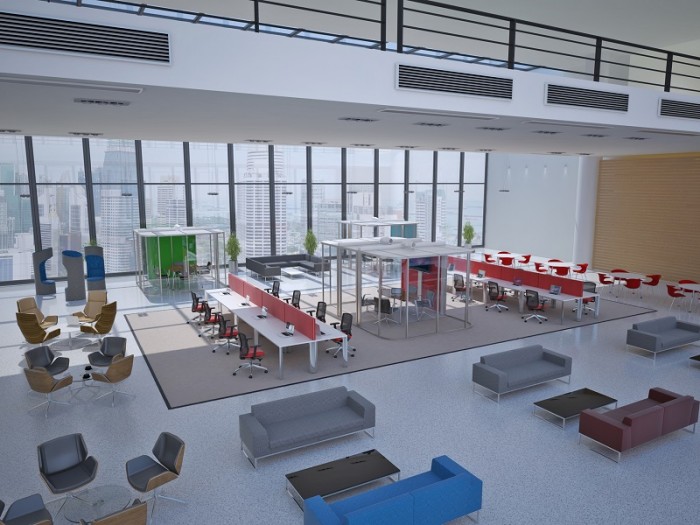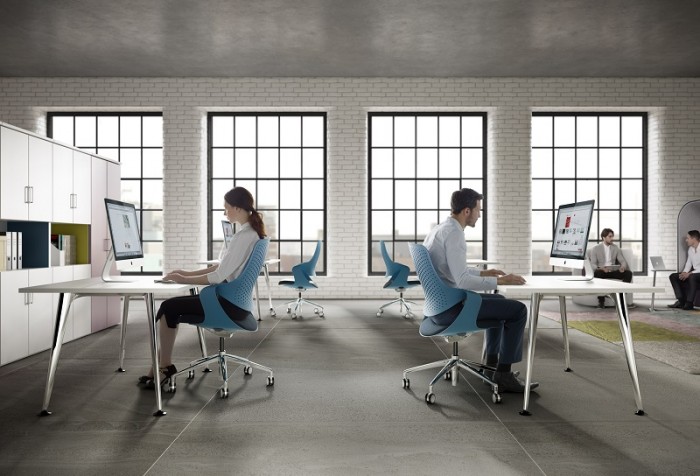Q&A with Mark Barrell, Boss Design
 Mark Barrell is Design Director at Boss Design Group. An industrial designer, he has specialised in the development of work seating over the last decade and developed products that sell across the globe. Boss Design Group is a designer and manufacturer of office seating. Established in the UK in 1983, the company now operates multiple production facilities around the world and has supplied more than half of the UK’s FTSE 100 companies.
Mark Barrell is Design Director at Boss Design Group. An industrial designer, he has specialised in the development of work seating over the last decade and developed products that sell across the globe. Boss Design Group is a designer and manufacturer of office seating. Established in the UK in 1983, the company now operates multiple production facilities around the world and has supplied more than half of the UK’s FTSE 100 companies.
What first got you interested in office design?
I spent most of the nineties working on furniture for the hospitality market, but by the turn of the millennium there was a real appetite for change emerging in the office sector and I knew that I wanted to be a part of it. Companies were starting to understand that every business is a people-business and that the quality of the workplace you provide for your employees is a significant ingredient in attracting and retaining the best people. Also, that the workplace is a physical manifestation of your brand; not just the building itself, but everything within it. You can create a culture with a well-designed workplace interior. If I had to narrow it down to one thing I’d say it was the opening of British Airways’ Waterside designed by Niels Torp, which was one of the first in the UK to set the tone for a new working culture.
“…the workplace is a physical manifestation of your brand; not just the building itself, but everything within it.”
How have you seen the industry change over the last five years?
Five years ago, we were still hungover from the recession and almost every property director in the country was under pressure to reduce its company’s footprint. This led a lot of businesses to look towards home-working and ‘agile’ workplaces on tighter desk ratios as a way to solve their problem and cut their space. It worked for some, but not many and we learned that those who lead with a people and productivity agenda, rather than a cost-cutting agenda are the ones most likely to create inspiring and valuable workspace. That said, there is no doubt that without the financial markets crashing in 2008 ‘flexible working’ in all its guises wouldn’t have picked up the momentum that it has. Today, businesses are implementing flexible work practices because they know it pays, driven by the competition for talent. The quality of interior and furniture design is more directly linked to a company’s bottom line then ever before.
Do you feel that there is now more of a crossover between hospitality and office?
Definitely. The ‘softening’ of the workplace has been a long-term project that has been crawling along for decades, but this year has seen the biggest push yet. Given the choice, most of us would spend our time surrounded by comfortable settings, softer lighting and more natural materials, which is why we are seeing so much wooden furniture specified. Designing products with a softer, more domestic or hospitality-driven feel is easy. However, the challenge for furniture designers is in creating workplace products that fulfil this aesthetic without compromising the functional, ergonomic or durability requirements that are necessary in an office. This will also work the other way, as hotels become a more popular third-space for work, their furniture will have to provide the same criteria. In effect, there won’t be much of a difference between products designed for either sector. Concierge working has been adopted by many of the UK’s larger employers, whose facilities teams are starting to look more closely at the hospitality sector for ideas concerning service provisions on bigger campuses. The ‘guest experience’ will be something that is as relevant to our workplace as our hotel stay.
“The ‘softening’ of the workplace has been a long-term project that has been crawling along for decades, but this year has seen the biggest push yet.”
What has been your favourite project to work on?
The most exciting always seems to be the next one! We have spent the last couple of years looking at the relevance of the traditional fully-adjustable task chair in the world of flexible and touchdown working. Research highlighted that very few people actually use the adjustments provided and that a product that requires ‘setting-up’ to accommodate individual users’ body-shapes, sizes and preferences was out of sync with the demands of a flexible work environment, where several different users can sit on a single chair every day. The result is a new collection of work seating that embodies a new agenda: to promote visual and functional simplicity, whilst improving the user experience. The first chair called Coza, designed with Martin Ballendat, has just been launched in the UK and will be closely followed by a further series next year.
Is there any particular designer who has inspired you through your career?
Many. For his sheer force of will, Norman Foster. For making complex problems seem simple, Jasper Morrison. For his attention to detail, David Bonneywell. For his daring, Marc Newson. For showing us the way, Coco Chanel. For his intelligence, George Nelson. For his sensitivity, Shiro Kuramata. For his entrepreneurialism, Yves Behar. For his perspective, Stefan Bench. For the publicity machine, Philippe Starck. For his untethered creativity, Thomas Heatherwick. For seeing the future, Jonathan Ive.
Contact Boss Design






